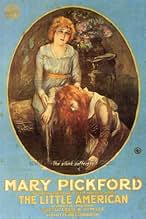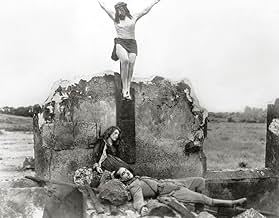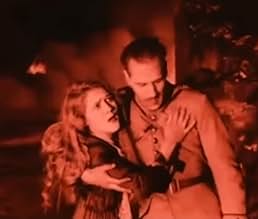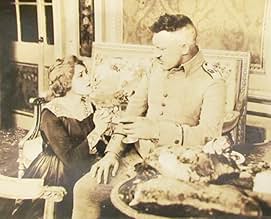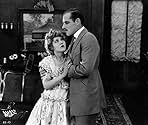IMDb RATING
6.3/10
774
YOUR RATING
A young American has her ship torpedoed by a German U-boat but makes it back to ancestral home in France, where she witnesses German brutality firsthand.A young American has her ship torpedoed by a German U-boat but makes it back to ancestral home in France, where she witnesses German brutality firsthand.A young American has her ship torpedoed by a German U-boat but makes it back to ancestral home in France, where she witnesses German brutality firsthand.
Wallace Beery
- German Soldier
- (uncredited)
Olive Corbett
- Nurse
- (uncredited)
Lucile Dorrington
- Nurse
- (uncredited)
Clarence Geldert
- Submarine Commander U-Boat 21
- (uncredited)
Carl Gerard
- Reverend
- (uncredited)
Robert Gordon
- Wounded Soldier
- (uncredited)
Gordon Griffith
- Child
- (uncredited)
Featured reviews
With the US having recently entered the First World War, the country's best known and most popular director teamed with its most beloved actress to fire a cinematic salvo in this flag-waving adventure.
In style this is something of a departure for DeMille. He more or less abandons his use of long takes, painterly shot compositions and predominantly visual narrative, in favour of rapid editing and lots of expository intertitles. Of course this is purely pragmatic it keeps the story moving along quickly and injects some excitement and tension into what is after all a propaganda piece. The heavier than usual use of intertitles also leaves no ambiguity about plot or character intention. Some of these editing patterns are quite effective for example, the crosscutting used when the ocean liner is torpedoed. However fans of DeMille's early silents will probably find themselves missing the more considered approach they will be familiar with. This is certainly one of his least graceful films.
The fact that The Little American is more action-centred means it is less acting centred there is not the same concentration on performance that you normally get with DeMille. For this reason this is not a particularly memorable role for Mary Pickford, and to be fair almost any actress could have played the part equally well. However the casting of Pickford would have been symbolic and psychologically effective at the time. Although the press had not yet labelled her America's sweetheart, she certainly occupied that position. Therefore DeMille did not have to go out of his way to endear the audience to the character of Angela Moore, because they had already formed an emotional attachment to Mary Pickford.
Regardless of how effective this picture was in its day it is really quite a mediocre effort when taken out of context. One interesting point though the one scene in The Little American that really looks like the typical DeMille is the one in which Pickford and Holt take refuge in a ruined church below the effigy of Christ on the cross. Throughout the picture the stars and stripes is treated with the same reverence and significance DeMille might give to a crucifix. This picture is another small step towards the iconic imagery and preachiness that would characterise his work from the twenties onwards.
In style this is something of a departure for DeMille. He more or less abandons his use of long takes, painterly shot compositions and predominantly visual narrative, in favour of rapid editing and lots of expository intertitles. Of course this is purely pragmatic it keeps the story moving along quickly and injects some excitement and tension into what is after all a propaganda piece. The heavier than usual use of intertitles also leaves no ambiguity about plot or character intention. Some of these editing patterns are quite effective for example, the crosscutting used when the ocean liner is torpedoed. However fans of DeMille's early silents will probably find themselves missing the more considered approach they will be familiar with. This is certainly one of his least graceful films.
The fact that The Little American is more action-centred means it is less acting centred there is not the same concentration on performance that you normally get with DeMille. For this reason this is not a particularly memorable role for Mary Pickford, and to be fair almost any actress could have played the part equally well. However the casting of Pickford would have been symbolic and psychologically effective at the time. Although the press had not yet labelled her America's sweetheart, she certainly occupied that position. Therefore DeMille did not have to go out of his way to endear the audience to the character of Angela Moore, because they had already formed an emotional attachment to Mary Pickford.
Regardless of how effective this picture was in its day it is really quite a mediocre effort when taken out of context. One interesting point though the one scene in The Little American that really looks like the typical DeMille is the one in which Pickford and Holt take refuge in a ruined church below the effigy of Christ on the cross. Throughout the picture the stars and stripes is treated with the same reverence and significance DeMille might give to a crucifix. This picture is another small step towards the iconic imagery and preachiness that would characterise his work from the twenties onwards.
With the Great War ravaging Europe as this film was made, it's a clear signal of patriotism from star Mary Pickford as she depicts the feisty "Angela". She's from wealthy stock and on her birthday is being courted by French "Count Jules" (Raymond Hatton) and by her slight favourite, the Prussian soldier "Karl" (Jack Holt). Before she has to make any choices, though, both head to their respective homes to fight. Shortly thereafter, she decides to travel to her aunt's home in France only for her liner to be torpedoed and for her to find that when she eventually arrives at her stately pile that the Bosch are intent on billeting there and behaving abominably too. Her American status gives her a degree of protection so long as she stays out of the conflict, and her stiff-necked friend "Karl" is amongst the occupiers, but when their cruelty to the house's staff and to an elderly gent shock her to the core, she decides that she can no longer stay on the fence. What now ensues sees her bravely attempt to help the Allied forces at great peril not just to her, but to her friend who would try to keep her as alive as his upbringing would permit! That merely invites a trial for espionage and treason and a firing squad for both of them looms... Can they find a way to escape the bullets? This is an effective propaganda tool, this film, illustrating just how ghastly the enemy were; how indiscriminate their violence was inflicted and how generally boorish and superior they were. Pickford and Cecil B. DeMille clearly wanted to ram that point home to domestic audiences and on that front they are quite effective. It really could have done with some more light, but even dingy as it is it delivers quite a potent analysis of uniformed thuggery tempered by conflicted romance and a semblance of human decency. It has it's zealous moments - from all sides, and in it's way it is quite a tough film to watch as though not graphic in terms of photography, it is in terms of psychology. It has a clear message to send and is worth a watch, I'd say.
Mary Pickford ("Born on the Fourth of July" as Angela Moore) is "The Little American" (of French heritage); she falls in love with Jack Holt (as Karl Von Austreim), who had moved to America with his German father and American mother. French-American Raymond Hatton (as Count Jules de Destin of the "Fighting Destins") has fallen in love with Ms. Pickford. The love triangled threesome eventually wind up in France, with the Great War (World War I, in hindsight) complicating their lives considerably.
A mostly entertaining, if propagandistically flawed, Cecil B. DeMille film. The torpedoing, and sinking, of a ship carrying Pickford is "Titanic"-like. The war intrigue gets dramatic as Pickford slowly becomes an undercover spy for France, while the Germans occupy her ancestral home. Of course, German lover Holt arrives. It was difficult to believe they took so long to recognize each other as he moved in for the rape, but it was dark; and, prior events had them believe each other dead. The film goes WAY over-the-top in its symbolism. Pickford was, by the way, Canadian - though, few could deny she wasn't a "Little American", for all intents and purposes.
FUN to spot "extras" who later became major stars include Wallace Beery, Colleen Moore, and Ramon Novarro - especially, watch for Mr. Novarro exhibiting "star" quality during one of the film's more memorable sequences: Pickford and the wounded soldier saluting each other as he is taken by her on a stretcher. Novarro even gets Mary Pickford to write a letter for him; obviously, he's got a future in pictures. Also future-bound is Ben Alexander, who plays the boy "Bobby"; he becomes a dependable child actor, and grows up to become a Jack Webb partner on "Dragnet".
******* The Little American (7/12/17) Cecil B. DeMille ~ Mary Pickford, Jack Holt, Raymond Hatton
A mostly entertaining, if propagandistically flawed, Cecil B. DeMille film. The torpedoing, and sinking, of a ship carrying Pickford is "Titanic"-like. The war intrigue gets dramatic as Pickford slowly becomes an undercover spy for France, while the Germans occupy her ancestral home. Of course, German lover Holt arrives. It was difficult to believe they took so long to recognize each other as he moved in for the rape, but it was dark; and, prior events had them believe each other dead. The film goes WAY over-the-top in its symbolism. Pickford was, by the way, Canadian - though, few could deny she wasn't a "Little American", for all intents and purposes.
FUN to spot "extras" who later became major stars include Wallace Beery, Colleen Moore, and Ramon Novarro - especially, watch for Mr. Novarro exhibiting "star" quality during one of the film's more memorable sequences: Pickford and the wounded soldier saluting each other as he is taken by her on a stretcher. Novarro even gets Mary Pickford to write a letter for him; obviously, he's got a future in pictures. Also future-bound is Ben Alexander, who plays the boy "Bobby"; he becomes a dependable child actor, and grows up to become a Jack Webb partner on "Dragnet".
******* The Little American (7/12/17) Cecil B. DeMille ~ Mary Pickford, Jack Holt, Raymond Hatton
Little American, The (1917)
** 1/2 (out of 4)
Cecil B. DeMille would eventually become known for his over the top films but I guess you can follow this type of film-making back to 1917 and this picture. The film starts off in America where Angela Moore (Mary Pickford) is being courted by both a German (Jack Holt) and a Frenchman (Raymond Hatton). When WW1 breaks out both men head off to fight for their different countries and soon Mary, now in France, comes under attack by German troops and Holt will have to decide to save her or stand up for his evil country. This film is so over the top in its patriotism that at times it becomes quite laughable. At the start of the film, when Pickford's character is introduced, we learn that she was born on the Fourth of July. When we first see her there's a big American flag waving behind her as she gives that lovely smile towards the camera. Overall this film is a mixed bag full of some great stuff but also containing a lot of weak stuff. The good stuff includes a strong performance by both Pickford and Holt who settle into their roles quite well. Apparently Pickford hated working for DeMille but that doesn't really show as she delivers her strong performance. The battle scenes, for the most part, are pretty good as well. The most interesting aspect of the film is how they show the evils being done by the German's at the time and this includes showing them raping some women as well as killing elderly men. The weak stuff is all the propaganda running throughout the film. I know this was common for the day but this film takes it to a whole new level. Another silly sequence is when Pickford's U-Boat is hit by a German torpedo. The special effects here are so bad that you can tell the boat seems to be a plastic one floating in a tub. The scenes towards the end where Pickford runs into Jesus on the cross doesn't contain the magic that DeMille was going for either. In the end, this is a mixed bag but fans of DeMille and Pickford would probably want to check it out but D.W. Griffith's Hearts of the World is much better.
** 1/2 (out of 4)
Cecil B. DeMille would eventually become known for his over the top films but I guess you can follow this type of film-making back to 1917 and this picture. The film starts off in America where Angela Moore (Mary Pickford) is being courted by both a German (Jack Holt) and a Frenchman (Raymond Hatton). When WW1 breaks out both men head off to fight for their different countries and soon Mary, now in France, comes under attack by German troops and Holt will have to decide to save her or stand up for his evil country. This film is so over the top in its patriotism that at times it becomes quite laughable. At the start of the film, when Pickford's character is introduced, we learn that she was born on the Fourth of July. When we first see her there's a big American flag waving behind her as she gives that lovely smile towards the camera. Overall this film is a mixed bag full of some great stuff but also containing a lot of weak stuff. The good stuff includes a strong performance by both Pickford and Holt who settle into their roles quite well. Apparently Pickford hated working for DeMille but that doesn't really show as she delivers her strong performance. The battle scenes, for the most part, are pretty good as well. The most interesting aspect of the film is how they show the evils being done by the German's at the time and this includes showing them raping some women as well as killing elderly men. The weak stuff is all the propaganda running throughout the film. I know this was common for the day but this film takes it to a whole new level. Another silly sequence is when Pickford's U-Boat is hit by a German torpedo. The special effects here are so bad that you can tell the boat seems to be a plastic one floating in a tub. The scenes towards the end where Pickford runs into Jesus on the cross doesn't contain the magic that DeMille was going for either. In the end, this is a mixed bag but fans of DeMille and Pickford would probably want to check it out but D.W. Griffith's Hearts of the World is much better.
When the US entered World War I, the government forced Hollywood to churn out propaganda films. THE LITTLE American is probably the best of the lot because it stars Mary Pickford.
Pickford plays a young woman torn between two men: Jack Holt (German) and Raymond Hatton (French), but her decision is delayed because of the war as both men enlist.
When the ship Pickford is sailing on is sunk by the Germans (think Lusitania) because it is carrying munitions, Pickford has a great scene as she stands on the lifeboat and yells at the German commander. Later on, of course, she runs into both Holt and Hatton when she is being held as a war prisoner at a château.
Director Cecil B. DeMille provides one truly great scene in this film as Pickford and Holt are wandering through a bombed-out village. They pass a destroyed church of which only one wall remains standing. Against the wall is a very large crucifix. As they stand and watch, the wall collapses but the Jesus figure remains, suspended in mid air. It's a very surreal moment in a film that is otherwise very straightforward and un-artsy.
Pickford is, as always, a pleasure to watch. She was always a very natural actress who avoided the arm-waving histrionics many other actors of the day used. She's also very very pretty. Holt is very good here in a leading-man role. Hatton is OK. Among the list of name actors in "extra" parts are Wallace Beery, Ramon Novarro, Colleen Moore, Ben Alexander, Hobart Bosworth, Norman Kerry, Walter Long, James Neill, and Edythe Chapman.
Not a great film, but interesting to see US propaganda at work.
Pickford plays a young woman torn between two men: Jack Holt (German) and Raymond Hatton (French), but her decision is delayed because of the war as both men enlist.
When the ship Pickford is sailing on is sunk by the Germans (think Lusitania) because it is carrying munitions, Pickford has a great scene as she stands on the lifeboat and yells at the German commander. Later on, of course, she runs into both Holt and Hatton when she is being held as a war prisoner at a château.
Director Cecil B. DeMille provides one truly great scene in this film as Pickford and Holt are wandering through a bombed-out village. They pass a destroyed church of which only one wall remains standing. Against the wall is a very large crucifix. As they stand and watch, the wall collapses but the Jesus figure remains, suspended in mid air. It's a very surreal moment in a film that is otherwise very straightforward and un-artsy.
Pickford is, as always, a pleasure to watch. She was always a very natural actress who avoided the arm-waving histrionics many other actors of the day used. She's also very very pretty. Holt is very good here in a leading-man role. Hatton is OK. Among the list of name actors in "extra" parts are Wallace Beery, Ramon Novarro, Colleen Moore, Ben Alexander, Hobart Bosworth, Norman Kerry, Walter Long, James Neill, and Edythe Chapman.
Not a great film, but interesting to see US propaganda at work.
Did you know
- TriviaFilm debut of Ramon Novarro.
- GoofsWhen Angela is returning to her bedroom after taking off the German commander's boots, the shot of her approaching the door is shown twice.
- Quotes
Count Jules De Destin: Since you are determined to stay, Mademoiselle, you may render France a great service.
- Alternate versionsThe George Eastman House version in their Motion Picture Study Collection has an uncredited piano score and runs 76 minutes.
- ConnectionsFeatured in The House That Shadows Built (1931)
Details
- Release date
- Country of origin
- Language
- Also known as
- The Little American
- Filming locations
- 2000 De Mille Drive Los Feliz, California, USA(Home of Cecil B. De Mille in Laughlin Park, shown in the first shot right after the opening credits)
- Production company
- See more company credits at IMDbPro
Box office
- Budget
- $166,949 (estimated)
- Runtime
- 1h 20m(80 min)
- Sound mix
- Aspect ratio
- 1.33 : 1
Contribute to this page
Suggest an edit or add missing content

